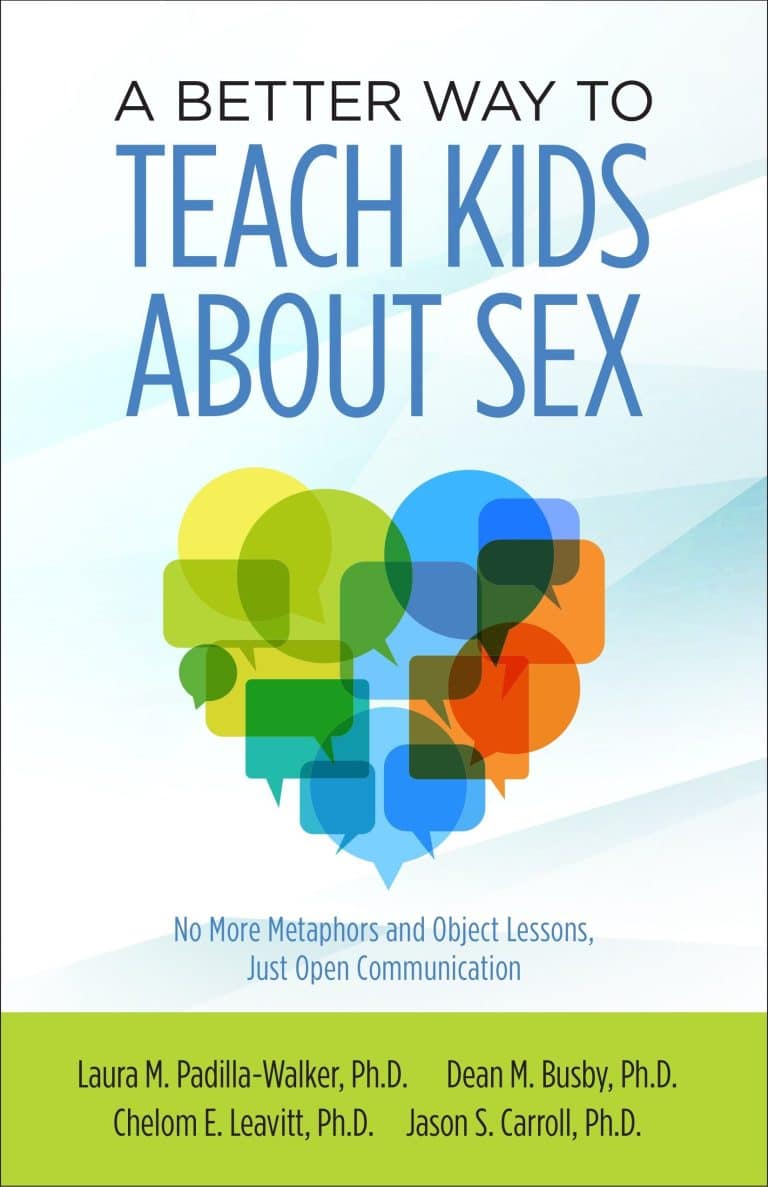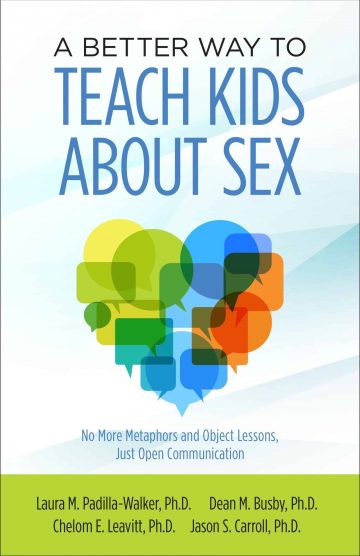 I’ve read a few “How to teach kids about sex” books in my time. Mostly I’ve read them because I don’t feel like my parents did a very good job in talking with me about sex…. and that’s all I knew. So, in preparation for when my children begin to ask questions, I decided to read a few different books and websites on the topic.
I’ve read a few “How to teach kids about sex” books in my time. Mostly I’ve read them because I don’t feel like my parents did a very good job in talking with me about sex…. and that’s all I knew. So, in preparation for when my children begin to ask questions, I decided to read a few different books and websites on the topic.
Here at the Exponent, we previously reviewed a Church of Jesus Christ of Latter day Saints (LDS / Mormon) inspired book about how the temple teaches us about sex… which none of us were particularly impressed with. So when I saw this offering by Deseret Book, I was curious. AND a bit anxious. Is there a truthful balance for us to teach our daughters about healthy sex, and could it even be inspirational?
This book is a resounding YES.
I’m not kidding.
To be clear, the book does not promise to be perfect for everyone. Rather, it introduces ideas about sexual wholeness, ties sexuality in with the eternal plan of God, and gives suggested ideas and discussions on hard topics such as same-sex attraction, pornography, masturbation, “modesty” and even sexual transgression. It does not contain advice or information for those who are struggling with gender identity, but rather the feelings and thoughts that we all have about sex. It also does not address transsexual beings, those with mixed reproductive organs and/or mixed chromosomes or other less typical variations in sexuality, but it is a good, basic, easy-to-read book that can create a healthy foundation for discussing these differences in a healthy way as the topic arises.
Divided into three sections, the book’s primary focus is on sexual wholeness. The sections include: Building a Foundation, which is focused on the idea that we are sexual beings by God’s design, Helping Your Child Understand the Physical Body– which teaches anatomy, and includes diagrams of reproductive organs as well as nude drawing of a biological male and a biological female, and Helping Your Child to Understand Specific Sexual Issues which addresses a variety of different sexual topics through to dating.
Here are some of my favourite quotes:
“There is not a clearly marked path for teaching healthy sexuality, just healthy principles and ideas.”
That is just what this book is—sexually healthy ideas and principles. No judgement. No condemnation. It even has sections to help parents deal with teenagers who are sexually experimenting—but the wisdom is not in condemnation, hellfire and brimstone—but rather to help children and teens develop healthy sexual habits and a healthy body image.
Teaching children that sexual feelings are wrong, sinful or something to be ashamed about is the exact opposite of what we need to teach and will produce long-term effects that can be devastating.
For reals. The focus of the authors of this book is to help us to teach our children that they are sexual beings, and that this is a good gift from God. To do this, they even debunk why so many of the lessons I had as a youth are wrong about chewed gum, handled cupcakes, cookies, chocolate bars are wrong. Very wrong.
There is no metaphor with which to compare sex because sex is the metaphor! So instead of asking, “What parts of life may be compared to sex?” we should ask, “How does sex help us better understand other parts of life?”– especially our discipleship and faithful progression as individuals, couples, and parents.
No, that was not a typo.
Yes, this book is by LDS authors.
No, I was not expecting such openness.
Yes, this book is published by Deseret Book.
And it is written by a collection of BYU academics, including Laura M. Padilla-Walker and Chelom Leavitt.
But mostly, the book invited me, as an adult and as a parent, to re-program any of the shameful sexual teachings I had growing up. This is one of the reasons I really loved this book—it helped me to feel good about myself in a sexual sense, rather than re-hashing the false ideologies taught to me as a youth that even having sexual thoughts would make me physically ugly, spiritually deceased, personally unwanted and completely unworthy.
If we try to protect our children from absolutely ever sexual thought, feeling, and potential mistake, we hinder their ability to grow and become self-sufficient in their sexual development.
Self-sufficient in sexual development? The concept floored me. I mean, in many ways I had to be self sufficient because my mother only discussed sex with me once, at bedtime, with the lights off, and if what she was saying was only something to be talked about in scary places late at night. And my husband? He’s still waiting for “the talk.” Any talk! So we *had* to be self-sufficient, and as the book teaches, learning things that are as important as sex in outside setting can be riddled with misinformation– I know I was naïve regarding many things, and had some very crazy misinformation buzzing around my head as a teen– mostly taught to me by other teens, but sometimes youth leaders. Thus, the ides of being sexually self-sufficient really appealed to me, and made me want to openly teach this to my children– free from shame, with the lights on.
Same-sex attraction / homosexuality is also discussed in a refreshing, healthy way. In this section, the authors discuss homosexuality in scientific terms, addressing the statistics and reality in regard to homosexuality and the population. They are clear: marriage does not “cure” homosexuality. Fasting and praying does not “cure” homosexuality. Nothing “cures” homosexuality. The authors repeat what we have all been taught about heterosexual marriage as the ideal in Mormon theology, but there is no demonizing of “same sex attraction”. Instead, there is a robust discussion about sexual development in heterosexual and homosexual terms that I found spiritually, mentally and emotionally enlightening. The authors also recommend parents seek out healthy support groups for teens who identify as same-sex attracted so that they can be in a position to continue to teach healthy sexual wholeness that can and should develop without bias, and with love.
Parenting from a sexual wholeness perspective helps parents promote growth rather than guilt in teaching children about sex.
“Growth rather than guilt”! That is what I want for my daughters! This is a theme and feeling throughout the book: sex is not something evil that we should fear or hide. It is healthy, SPIRITUAL, and a good thing for us to discuss openly with our children through their lives. Even masturbation is discussed, recognizing that self-discovery is an important part of childhood, youth and so on. With this topic, and even the topic of pornography, the authors teach us how to recognize healthy ways in which to react, teach and support children in learning about their divine sexual identity. Shame is not included in any way. Rather, healthy sexual development for our bodies, minds and spirits is the focus with the divine theme that our sexual development is important and beautiful.
Possibly my favourite quote is this one:
When we describe a modest home, we are not describing whether the windows are “cover up” and whether the decorations are “revealing.” Instead, we are describing an attitude of reserve and a lack of pretentiousness. The same applies to personal modesty.
“Modesty” teachings in the book are addressed in the same way, as in– modesty is NOT the overt sexualization of females. The book clearly teaches that being modest is equivalent to be being humble; it not sexual, and teaching that is sexually motivated is not productive, and is harmful. The book warns that the emphasis on females to be “modest” by covering up, or in focusing on the length of their skirts is a way in which to teach poor self-esteem and create poor body-image issues. It also warns young men to be modest in dress (as in, not flashy or overly expensive/worldly- same for young women), attitude and appearance, and illuminates the concept as one that should be taught to both males and females equally.
At the end of the day, it is clear that no book is perfect for teaching sex—it is the parent (or sadly, the teacher) who educates children and youth about sex and sexual attitudes. This book is clearly in line with the teachings of the Church of Jesus Christ of Latter-day Saints, but it is NOT grounded in the Mormon cultural teachings I grew up with which were focused on judgement, shame, sexual modesty/rape culture, and anti-gay sentiments. It is a refreshing change that brings a Christlike focus into a healthy, happy and spiritual discussion on sex.
I recommend this book as a great launching point for teaching children about sex. Furthermore, I think this book should be required reading for Church Youth Leaders and youth teachers who often have the sticky job of addressing chastity, and inadvertently pile on guilt, shame, and unhealthy sexual attitudes (or at least my youth leaders did this.) I additionally found the book to even be healing for those who carry residual sexual shame that may have been lopped upon you in ill-taught, unChristlike, gum-chewing metaphors that teach that sex is bad and unnatural.
It is available for purchase for $18.99 through Deseret Book and other retailers. It is truly the best introductory LDS-directed sex education book I have ever read.





3 Responses
Thanks for the review! I was really curious about this one and I think I’ll pick it up!
Wow! This sounds really encouraging. Thanks for the review, Spunky!
Just put this on my “to read” list. Thanks.